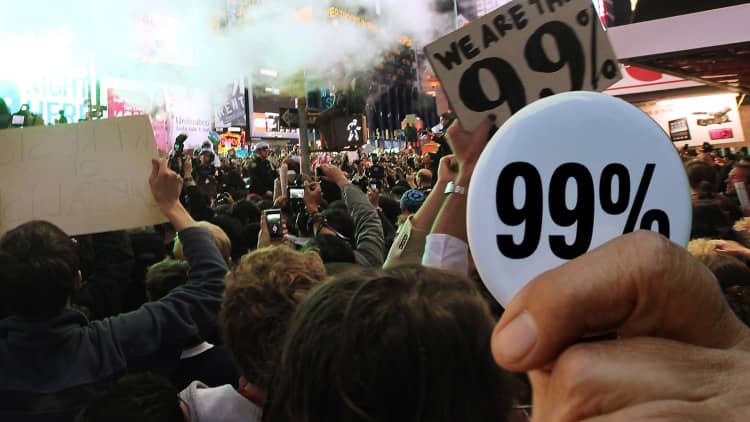Household wealth in the U.S. is continuing to see an "unbroken spell of wealth gains" but China has replaced Japan in second place in the world wealth hierarchy, according to Credit Suisse's latest report on global wealth.
During the 12 months since the bank's last report to mid-2018, aggregate global wealth rose by $14 trillion to $317 trillion, representing a growth rate of approximately 4.6 percent, according to the Global Wealth Report 2018, published by Credit Suisse's Research Institute on Thursday.
This growth rate was lower than last year, but higher than the average growth rate in the post-2008 era, the report noted.
"The United States continued its unbroken spell of wealth gains since the global financial crisis, adding another $6 trillion to the stock of global wealth," Credit Suisse's annual report noted, saying that rising household wealth in the U.S. was "seemingly relentless."
Total wealth and wealth per adult in the U.S. have grown every year since 2008, even when total global wealth suffered a reversal in 2014 and 2015. The U.S. has accounted for 40 percent of all increments to world wealth since 2008, and 58 percent of the rise since 2013, Credit Suisse said.
What's behind wealth growth?
Essentially investigating household wealth around the world, this year's report found that global wealth continued to grow at a moderate pace with the rise partly reflecting a continued rise in equity markets. More so, however, rising wealth was due to increases in non-financial assets owned by the middle-class.
"Financial assets … continue to make a substantial contribution to growth of household wealth, accounting for 41 percent of the increase in gross wealth worldwide, and more than two-thirds of the rise in North America. However, non-financial assets have grown faster in recent years. Over the past 12 months, they have provided the main impetus to overall growth in all regions except North America, accounting for more than 75 percent of the rise in China and Europe, and all of the rise in India."
However, the report's authors at the bank's research institute noted that the unbroken spell of rising wealth in the U.S. could come to an end.
"While not wishing to cast doubt on the 'Trump Effect' on financial markets, it seems inevitable that the uninterrupted spell of increasing wealth in the U.S. will come to an end at some time. Fortunately, there are signs that wealth inequality is no longer rising, which should mitigate the impact of any setback on the middle classes," the report said.
China clearly established
Another prominent feature in this year's wealth report is the rise of China to second place in terms of world wealth rankings. "The main outcome of the new wealth valuations is confirmation of what many observers already suspected – that China is now clearly established in second place in the world wealth hierarchy," the report noted.
"The country overtook Japan with respect to the number of ultra-high net worth (UHNW) individuals in 2009, total wealth in 2011 and the number of millionaires in 2014. Nevertheless, the data shows that mean wealth per adult in China ($47,810 in mid-2018) remains far below the level in Japan ($227,240) and median wealth lags even further behind Japan ($16,330 versus $103,860).
One of the report's authors told CNBC that the general trend is one of rising household wealth.
"We are seeing wealth increase, we are seeing that the distribution, regionally, is also moving along so it was made as a comment that China is now emerging as the second holder of total wealth," Nannette Hechler Fayd'herbe, global head of Investment Strategy & Research at Credit Suisse, told CNBC Europe's "Squawk Box" Thursday.
"Of course, if you break it down into mean wealth per person and median wealth per person there is still a catch up, but the general sense is that there has been progress in the formation of wealth."
Wealth inequality
Wealth inequality is a key feature in the report, which noted "that the bottom half of adults collectively owns less than 1 percent of total wealth, the richest decile (top 10 percent of adults) owns 85 percent of global wealth, and the top percentile alone accounts for almost half of all household wealth (47 percent)."

Credit Suisse said there is reason to believe that wealth inequality is not rising.
The share of financial assets (among many of the the richest people, and richest countries) peaked in 2015 and has been declining since then, the bank said.
"In previous reports, we predicted that wealth inequality would follow suit — possibly with a slight lag — and there is evidence that this is now the case. The share of the top decile and the top 5 percent remains at the same level as in 2016, while the share of the top 1 percent has edged down from 47.5 percent to 47.2 percent according to our best estimate."
While it is too early to say that wealth inequality is now on a downward trend, the prevailing evidence suggests it may well have leveled out, albeit at a very high level, Credit Suisse noted.


